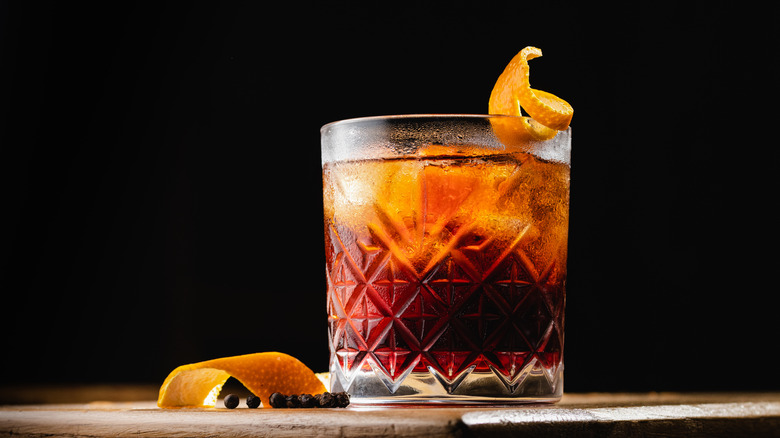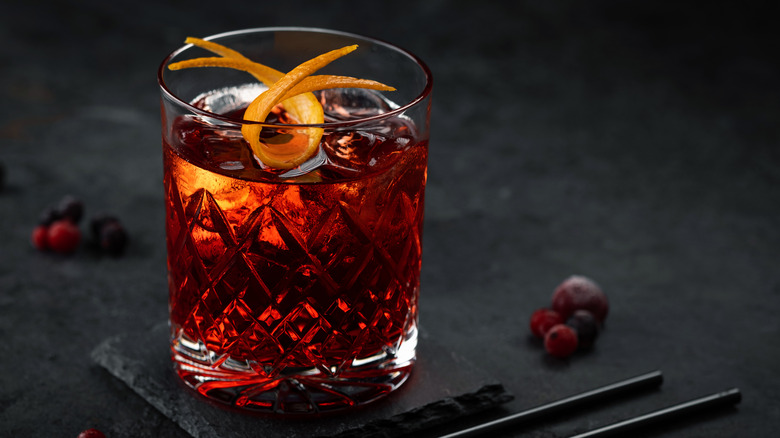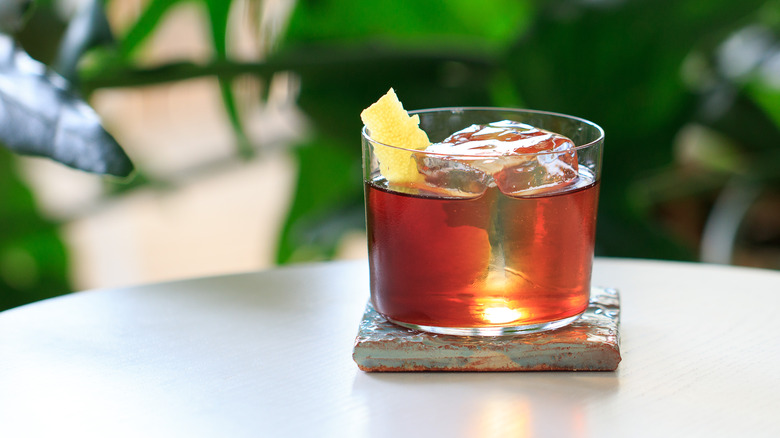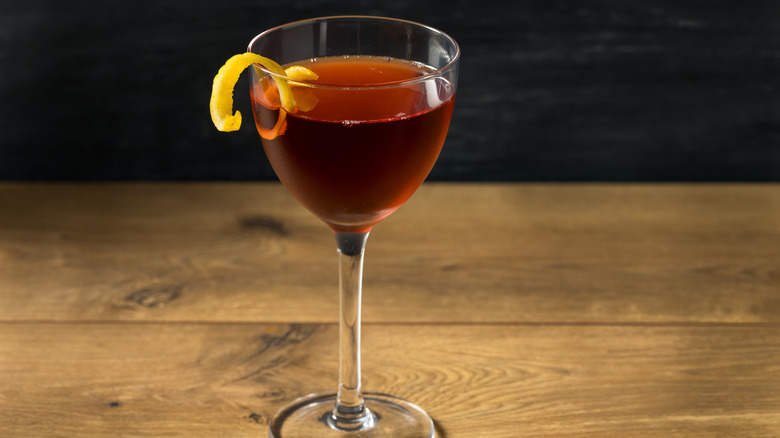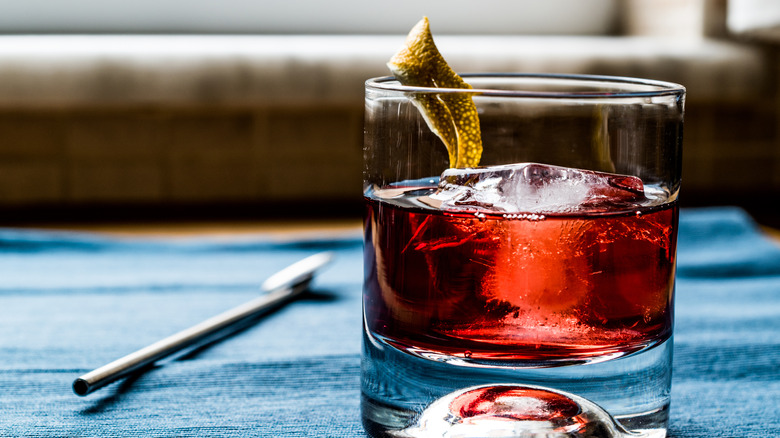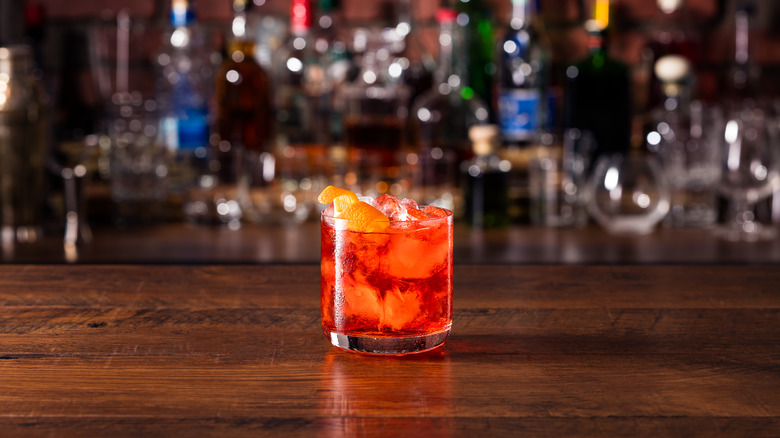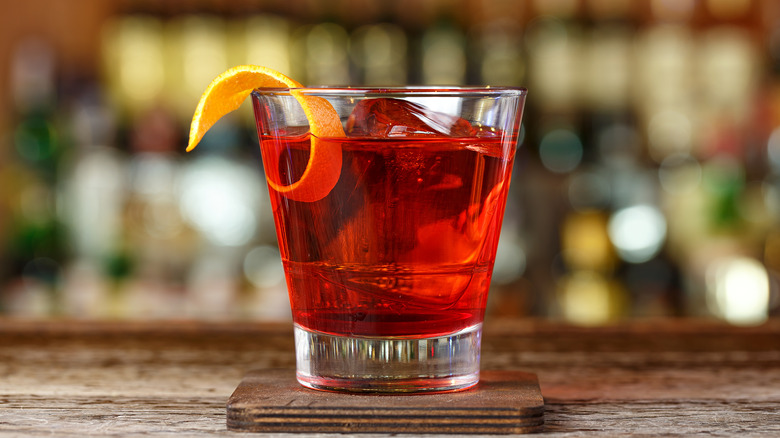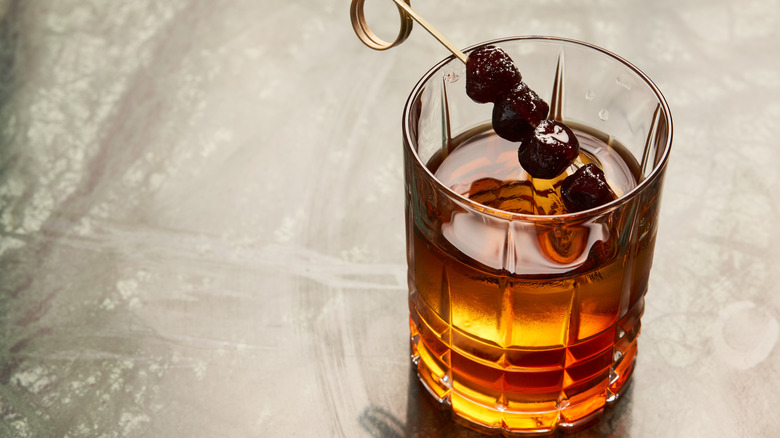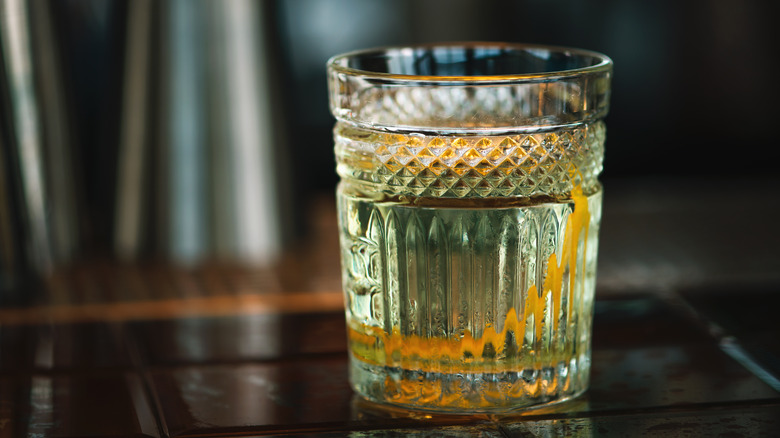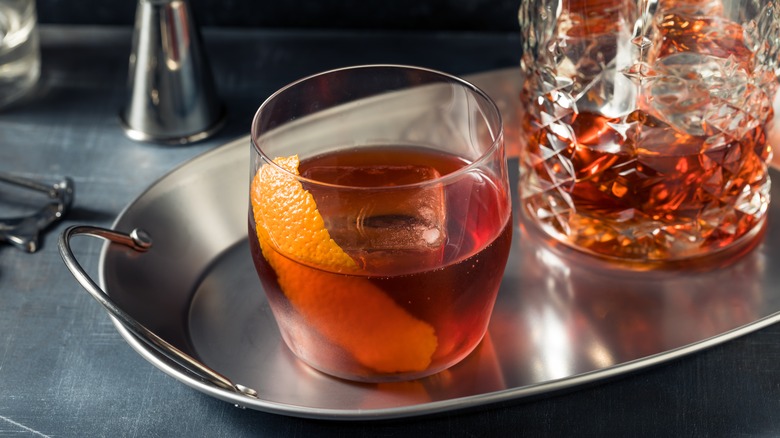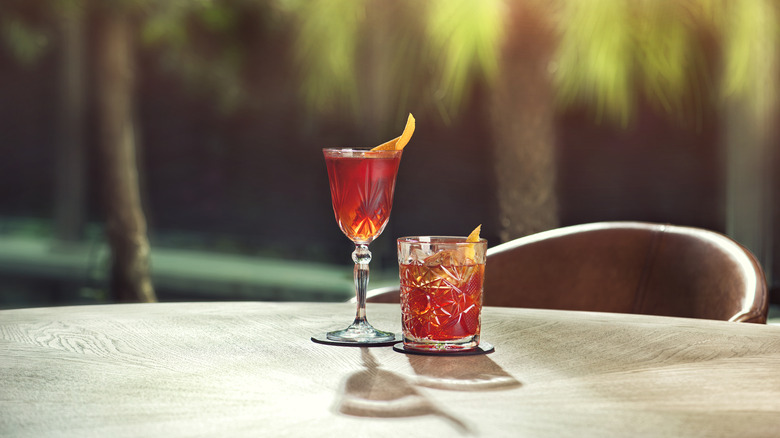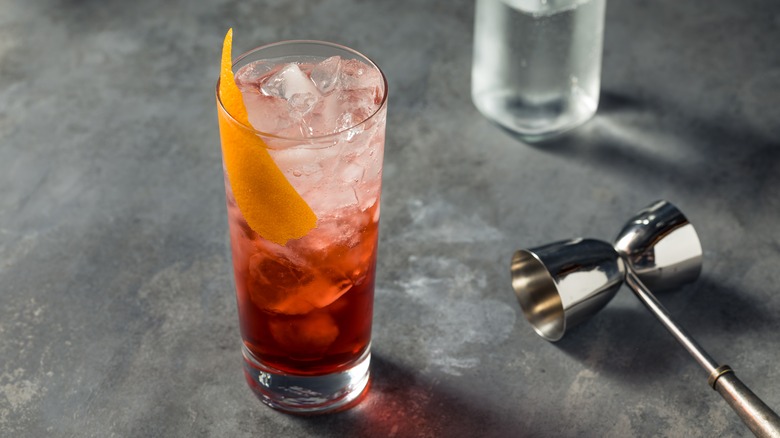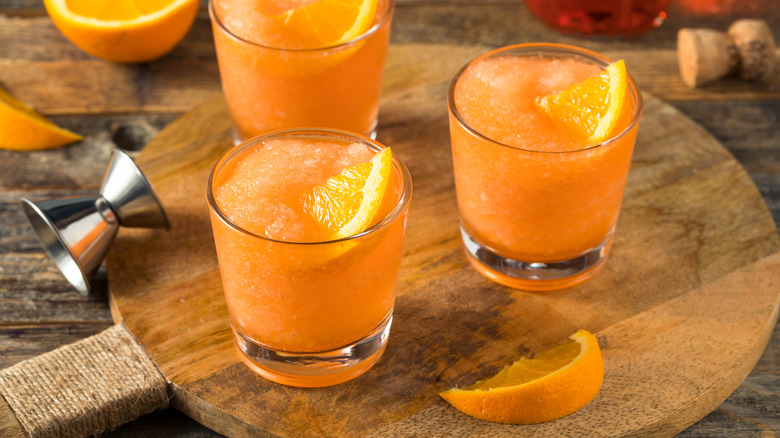12 Negroni Variations You Need To Try
The Negroni is one of the most iconic drinks in the spirits world. The Italian-born cocktail has sustained popularity for over a century, and there are no signs of it stopping any time soon. The equal parts combination of gin, sweet vermouth, and Campari was originally created in 1919 for Count Camillo Negroni in a Florence bar. He requested his uber-popular Americano cocktail be strengthened, so the bartender replaced the soda water with gin, and Italy's greatest export was born, via Condé Nast Traveller.
The best part of a Negroni is that each component can be easily detected and enjoyed. If you focus your mind on one particular ingredient, you can have three different sips in one glass. This equal parts spirit, sweet, and bitter template is what makes the Negroni a bartender's dream —and countless riffs have been born of it. Some are simple, some are more complex, and some came about from pure blunders. Regardless, if you like Negronis, you should try these variations. And even if you don't like Negronis, one of them might be the one that changes your mind.
The Boulevardier
There aren't many positives that came out of Prohibition, but the Boulevardier is certainly one of the few that did. Once Prohibition became law in the United States, many American bartenders and bar owners emigrated to Europe to continue their careers, one of whom was Harry MacElhone, per Imbibe. After initially moving to London, he eventually opened up his own bar in Paris and named it "Harry's New York Bar."
American expatriates who moved overseas to tend bars brought with them cocktails from their homes and found new ingredients to experiment with. This was the case for MacElhone who, in the mid-1920s, replaced the gin in a Negroni with bourbon, and the Boulevardier was born. According to Imbibe, this cocktail gets its name from being the favorite of Erskine Gwynne, the editor of an arts and culture magazine in Paris called "The Boulevardier." After it gained popularity, the cocktail was published by MacElhone in his 1927 book, "Barflies and Cocktails."
The swap of gin for bourbon in the Boulevardier makes for a dark liquor cocktail that's drinkable year-round. The fuller-bodied and more complex flavor profile of bourbon helps tame the Campari, which is what makes this cocktail so easily palatable and harmoniously balanced. Whiskey cocktails are usually more popular during the colder months, but alongside Campari and vermouth, this bright and balanced drink can warm you up as well as cool you down.
Mezcal Negroni
For the mezcal Negroni, all you have to do is swap out the gin for mezcal — simple as that. According to Punch Drink, there is no single bartender credited with mixing the first mezcal negroni, as this cocktail seems to be a natural product of the recent mixology boom.
In the mid-2000s, as cocktail bars continued to pop up and thrive, decades-old masterpieces and modern classics shared menu space. The agave-based spirit mezcal began surging in popularity, and as classics like the Negroni came back into the limelight, a combination of the two was inevitable. Mezcal is a smoky, sweet, and earthy spirit that's punchy and strong. The combination of Campari and sweet vermouth provides a distinct layering of flavors and textures, and the result is a new, yet familiar cocktail that will not be leaving drink lists anytime soon. In fact, the mezcal Negroni has become so popular that the variation has inspired its own riffs, such as Sarah Morrsisey's Negroni Absinthe and Leanne Favre's Negroni de Nubes.
This cocktail is the epitome of what makes cocktails and the world of spirits so exciting. It's resourceful, yet simple; fresh, yet familiar. If you have the means to make one at home, do it. If not, order one the next time you're out. You won't regret it.
The Old Pal
The Old Pal requires two modifications to the original recipe instead of one. It is, however, another creation credited to Harry MacElhone. But the exact history of the cocktail is a bit murky, according to Cold Glass. MacElhone credits the cocktail to a man named William "Sparrow" Robinson, a sports writer for the New York Herald-Tribune's Paris office. A frequent customer at MacElhone's New York Bar, Robinson supposedly referred to everyone he encountered as his "old pal." In MacElhone's 1927 book, he tells the story of the drink's conception, citing how Robinson asked for a drink consisting of Canadian rye, dry vermouth, and Campari. "You can't go wrong," he stated.
He was right. The swap of gin for rye — and sweet vermouth for dry — turned the Negroni into a completely new, layered, complex cocktail worth trying. It may not be the best Negroni variation to try first as it is quite dry and sharp. Rye whiskey does not carry the same sweetness as bourbon does in a Boulevardier, and the dry vermouth obviously contributes to a more palate-cleaning sip. Plus, per Cold Glass, the Old Pal calls for a twist of lemon instead of orange, which does more to brighten the cocktail (whereas orange sweetens it). The Old Pal is an excellent cocktail, though, and if you have already acquired the taste for Campari and Negronis, it only makes sense to give the Old Pal a shot.
The Dear Jane
This variation of the Negroni is one of the most simple on this list. The Dear Jane was first created by Zachary Gelnaw-Rubin in 2015 at a New York City bar called Attaboy. This cocktail is simply a regular Negroni with the addition of a small amount of elderflower liqueur — another great way to enhance the Negroni in the summer months.
Normally, Negronis (and most cocktails with Campari) call for a twist of orange as a garnish. The Dear Jane, however, calls for a twist of lemon. The difference may seem negligible, but, it's anything but. A spritz from an orange peel highlights the sweeter characteristics of the Campari, whereas that of a lemon highlights the brighter, sharper ones.
The elderflower liqueur provides a very specific sweetness that helps bring out the herbal notes of the vermouth. Plus, the gin combined with the elderflower is a match made in botanical heaven. If the addition of the lemon peel turns you off, you can rest easy knowing that the elderflower liqueur with smooth out any tartness. It's no wonder the stuff is nicknamed "bartender's ketchup."
The Gloria
The origin of the Gloria is disputable. Some credit the cocktail to Trader Vic's in the late 1940s, and others claim it was created by Marie Glory, a French silent-film actress who came up with the drink for a cocktail competition in 1929 (via Lifehacker). Either way, the Gloria, which is referred to as the offspring of the Negroni and Martini, is a delicious variation that brings something new to your stirring glass.
This riff increases the gin, lowers the Campari, swaps the sweet vermouth for dry, and adds Cointreau. The result is a delectable, mild, but complex cocktail that is everything you love about a Negroni on a more softened scale. The Campari and vermouth measurements are cut in half to just 15 milliliters, and the Cointreau at the same amount punches up the Campari's orange notes and balances the dry vermouth to create an intriguing contrast between sweet and sharp. The lemon peel garnish also contributes to this incredible balance of flavors and aromas. The best part is, this cocktail can be made with ingredients you probably already have in your home bar.
Normally served up in a coupe glass, this drink is a translucent glow of pink — unlike any other cocktail. It's a wonder this cocktail isn't more popular.
The Cardinale
The variation uses the same measurements as the Negroni but replaces the sweet vermouth with dry. According to Explore Italy, the original Cardinale was born in the 1950s at the Hotel Excelsior in Rome. After an American film studio opened up nearby, the city began to thrive again, and cocktail culture became a large part of its identity. Tourists from America and elsewhere visited the eternal city to try new and innovative cocktails mixed by experienced professionals. Of all the bars in the area surrounding the U.S. Embassy, it was Hotel Excelsior that drew the most people.
One guest in particular inspired renowned Roman bartender Giovanni Raimondo to create a new drink — one that was especially for him. A well-known German cardinal, Cardinal Shumann, consistently enjoyed an aperitif consisting of gin, Campari, and Riesling wine. One day, Raimondo suggested the Riesling be replaced with dry vermouth and the regular clove and cinnamon garnish with a simple lemon peel. Cardinal Shumann obliged and was quite pleased with the new drink, and soon thereafter, the rest of Rome was as well. The name of the cocktail is actually believed to come from the distinct red color worn by Roman Catholic cardinals — not the Cardinal who it was made for.
The Cardinale is essentially a drier Negroni. The Campari and gin are equally highlighted, making the Cardinale an extra stiff cocktail worth trying at least once.
Cynar Negroni
This Negroni variation is the first on our list to not include Campari. Instead, the Italian bitter is swapped out for Cynar, a different Italian bitter. While Italian aperitifs such as Campari, Aperol, and fernet continue to thrive, many bartenders consider Cynar an unsung hero.
The liqueur is made with 13 different botanicals, but the primary ingredient is artichoke. Cynar is classified as an amaro, or a low ABV liqueur that helps ease the stomach. As opposed to Campari, Cynar is actually a digestif (or, after-dinner drink). The appearance of Cynar may seem off-putting, as its dark, brutish color may misrepresent itself. You may expect this variation to taste harsher than the original, but it turns out our Cynar is sweeter than many of its fellow amari.
According to Steve the Bartender, the Cynar Negroni is a shorter cocktail than the original. While the bitterness of Campari is elongated on the palate, Cynar is sweeter, but also crisper. If you happen to come across Cynar in your local liquor store or on a cocktail bar menu, give it shot. You'll be glad you did.
White Negroni
The White Negroni is different but delicious. It has everything you love about a Negroni but has its own character. Purchasing the ingredients may seem to be a lot to spend for a single drink, so if you ever find it on a menu, take advantage.
Of all the cocktails on this list, the White Negroni may have the most interesting origin. In 2001, the former director of Plymouth Gin, Nick Blacknell, found himself craving a Negroni while traveling in Bourdeaux, France, per Punch Drink.
Due to a lack of bar options, Blacknell attempted to find the ingredients in a local store. It was his friend, Wayne Collins, who suggested they make use of French ingredients. A wine-based aperitif, called Lillet Blanc, replaced the sweet vermouth, and the Campari was replaced with Suze, a bitter French aperitif. As the director of Plymouth, Blacknell did not have to worry about replacing the base spirit.
A few Negronis later, the two realized they had struck gold, but it took a while for it to catch on. It really hit its stride in 2002 in the U.S., before Suze was even available in America. Blacknell had hired Simon Ford as a brand ambassador for Plymouth, who soon met the most important patron of the cocktail — Audrey Saunders, the eventual owner of the Pegu Club. Saunders smuggled bottles of Suze back from England and put the cocktail on her menu illegally. As popularity grew, Pernod-Ricard finally began importing Suze in 2012.
Cold brew Negroni
A classic Negroni plus cold brew coffee — it's as simple and delicious as that. The first known cold brew Negroni was built by New York City bartender Pam Wiznitzer, according to Liquor.com. But her creation isn't as simple as adding coffee to a Negroni. Wiznitzer infuses a bottle of Campari with cold brew coffee and then mixes the cocktail like she would any regular Negroni.
There are other ways to make your own, though, without altering an entire bottle of Campari. You can, as stated above, just add a splash of cold brew to your Negroni, or you can use a cold brew liqueur. According to The Educated Barfly, Mr. Black Coffee Liqueur is an excellent candidate for this. The vodka-based liqueur is a great way to get that robust coffee flavor in cocktails without losing out on alcohol content. Mr. Black is also a great choice for an espresso martini.
The cold brew Negroni amplifies the original's versatility in regard to convenience. Some cocktails are only good during certain parts of the year or at particular times of the day. Not only is this variation fit to drink year-round, but it is also the perfect way to boost your Negroni during brunch, provide some extra zip at happy hour, or help you turn on the afterburners following a meal. Negronis and coffee are two of life's simplest pleasures, and a simple combination of the two makes the cold brew Negroni a complementary and happy marriage.
Negroni sbagliato
Like the Negroni, the Negroni sbagliato, or "wrong Negroni," was born in Milan. Per La Cucina Italiana, in 1972, bartender Mirko Stocchetto of Bar Basso was mixing a Negroni when he mistakenly picked up a bottle of sparkling wine instead of gin and poured it into a glass with the other two ingredients. He gave it try, enjoyed his blooper, and the cocktail caught on. That's really it.
The cocktail has been popular ever since, as it is commonly found to be a more drinkable and refreshing version of the Negroni. Really, the Negroni sbagliato focuses on the balance between sweet vermouth and Campari, just like the classic Americano. The alcohol content is also much lower than the original, and the effervescence from the sparkling wine helps to soften the Campari.
For those who may find a Negroni to be too harsh, this "wrong" version may just be what changes your mind. Variations on the original mistaken cocktail include using champagne instead of sparkling wine, an elegant, yet simple way to bring some extra complexity and refreshment to this straightforward variation.
Negroni swizzle
Most of the variations on this list simply require a swap of one or two of the original ingredients, but this one only requires one additive (via Roberts and June). By simply topping your Negroni with club soda, you can enjoy everything you love about the cocktail on a more mellow, bright, and refreshing level.
Swizzle cocktails are generally highball cocktails filled with crushed ice. According to The Manual, the name "swizzle" comes from the tool used to mix the ingredients. There's an evergreen tree native to the Caribbean that sprouts little branches with tiny arms on the end. These branches were broken off and used to mix refreshing drinks as early as the 17th century. In the 1920s, swizzle sticks made their way to Buckingham Palace and other areas of high society where they were used to subdue the carbonation in champagne.
Because of the swizzle stick's Caribbean origins, most swizzle cocktails are rum-based. However, because it is the method, not the spirit, that earns the cocktail its name, basically any soda-topped cocktail can be called a swizzle.
In the case of the Negroni swizzle, the soda water simply adds carbonation to the cocktail. For those who may find the punchiness of Campari too overpowering or just want to make their favorite drink more suitable for a hot summer's day, the Negroni Swizzle can help you accomplish both.
Frozen Negroni
If you like the extra refreshment from the Negroni swizzle, why not go a step further with a frozen Negroni? The "fro-groni" was first blended by the legendary Jeffrey Morgenthaler as his go-to summer drink at home. After more and more people began asking him about it, he decided to bring it to his bar in Portland. Jeffrey Morgenthaler is responsible for many modern classics (such as the Bourbon Renewal), and the frozen Negroni is no exception.
The frozen Negroni is made using the original cocktail ingredients and is then blended with some orange juice and ice. Orange juice is the perfect mixer for a Negroni because it gives the frozen edition more body. If the addition of simple syrup seems too sweet, it is important to remember how much ice is required to make the drink — and ice equals dilution. The small amount of simple syrup helps to level out the higher water content and allows the Negroni itself to come out and shine. The result is a boozy, frozen treat fit for a sweltering hot day. The next time a heat wave hits your location, you'll know what cocktail to turn to.
